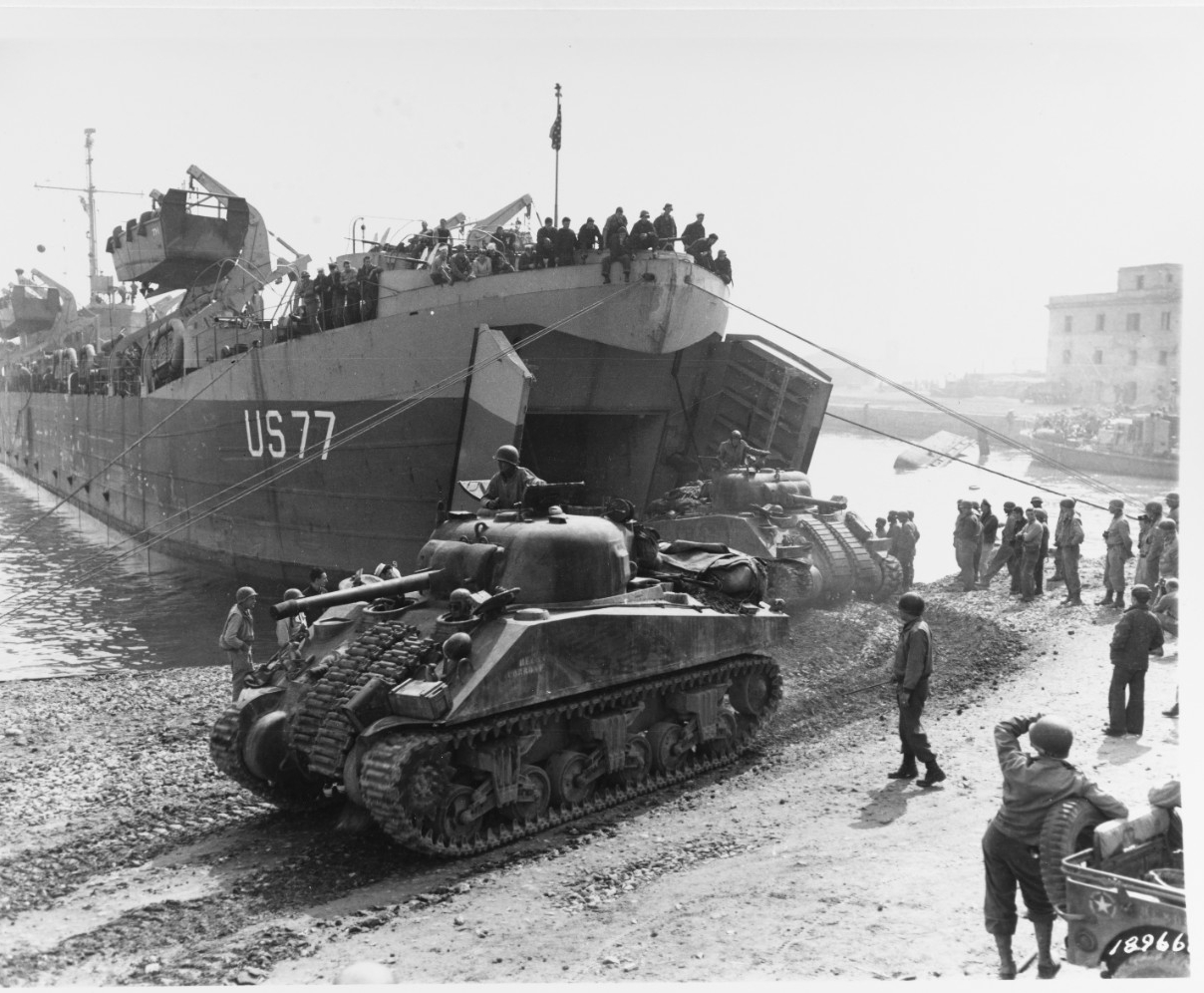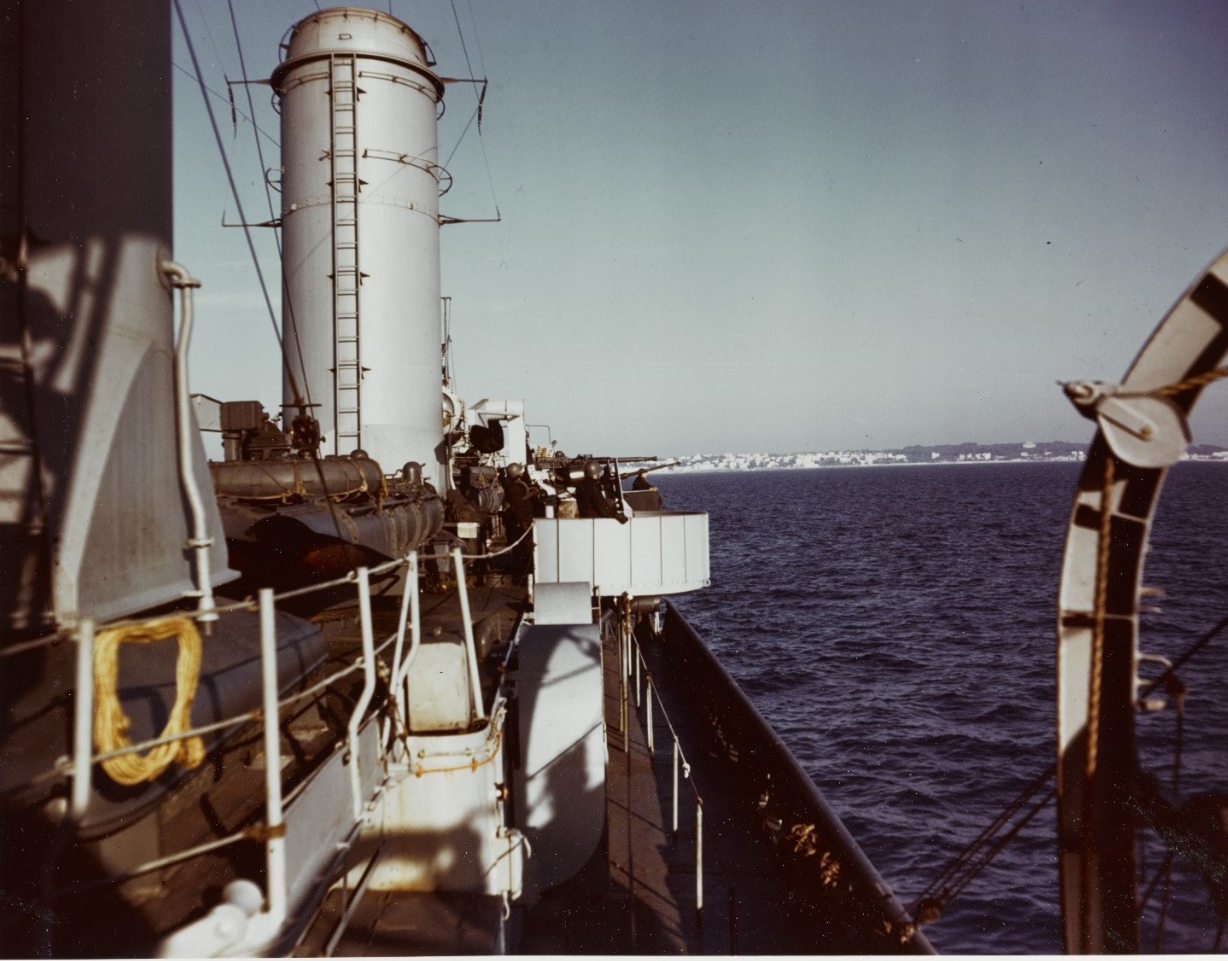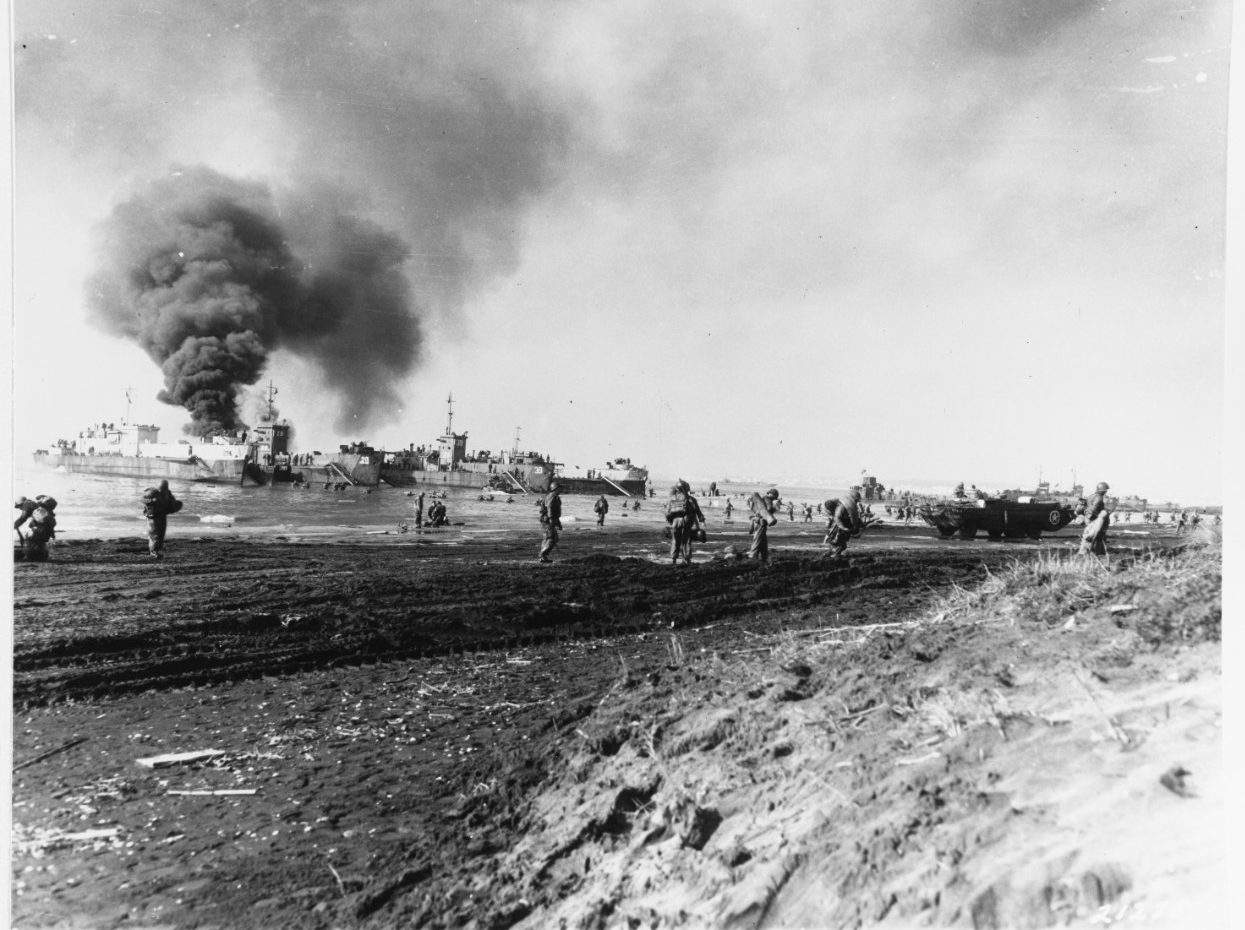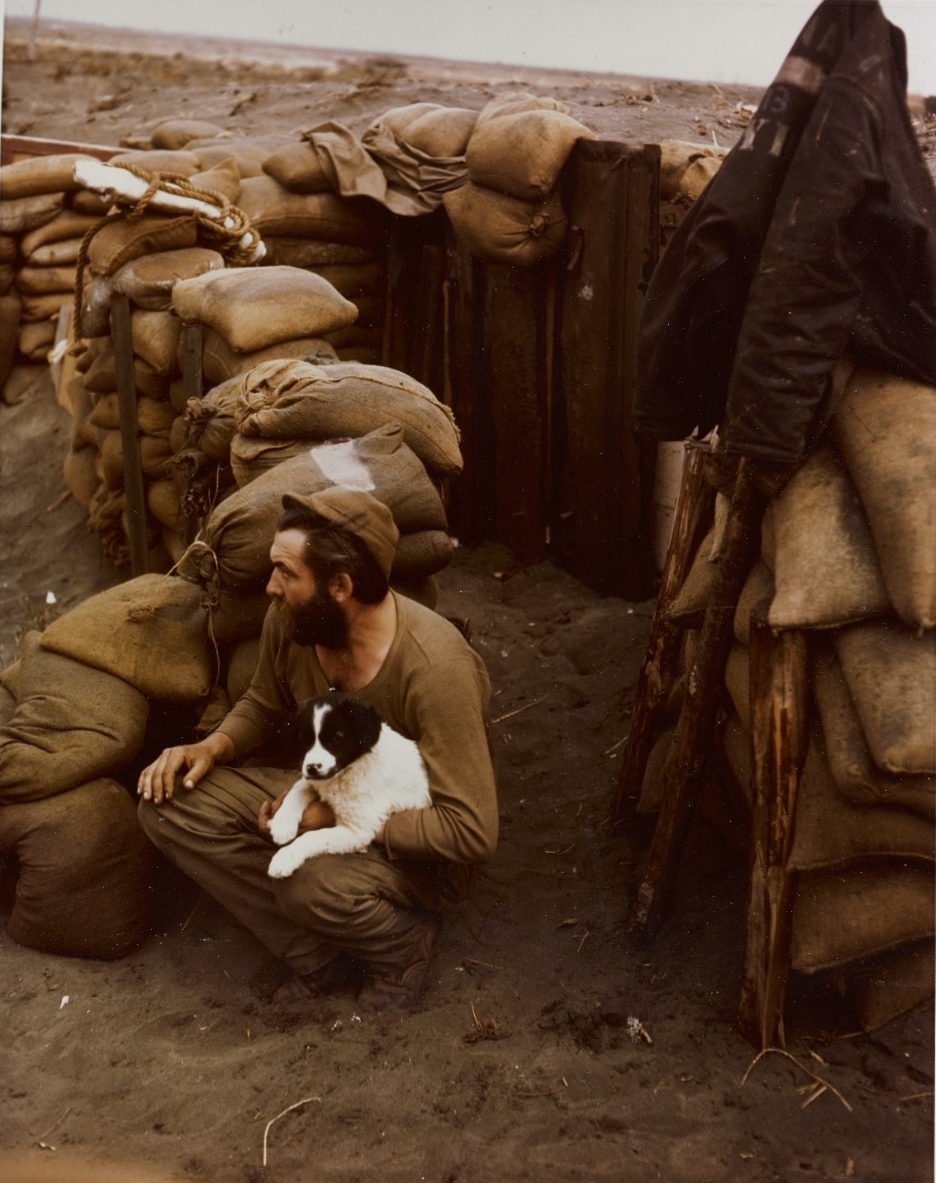Operation Shingle: Landing at Anzio, Italy
22 January 1944
At the conclusion of Operation Avalanche, Allied leadership was optimistic that Rome might fall as early as late October 1943. These hopes rapidly diminished once it became clear that the German commander in Italy, Field Marshal Albert Kesselring, planned to stubbornly contest the Allied advance from Salerno. Poor weather, mountainous terrain, and a series of east-west river crossings aided the German defenders, who slowed the Allied armies to a crawl up the Italian peninsula in the fall of 1943. By the end of the year, the Allies faced a stalemate at the Germans’ Gustav Line, approximately halfway between Salerno and Rome.[footnote:footnote0]
In early November 1943, the overall Allied commander in Italy, British General Sir Harold Alexander, decided that another amphibious operation would be required to force the Germans from their position and open the road to Rome. Dubbed “Shingle,” the operation was scheduled for the third week of January 1944. The plan called for landing the U.S. VI Corps under Major General John P. Lucas at Anzio, a resort town on Italy’s western coast approximately 80 miles behind the Gustav Line and 35 miles from Rome. The Anzio landings would be coupled with a breakthrough at the Gustav Line by the remainder of Lieutenant General Mark W. Clark’s Fifth Army. [footnote:footnote1]
- [footnote:footnote0] Carlo D’Este, World War II in the Mediterranean, 1942–1945 (Chapel Hill, N.C.: Algonquin Books of Chapel Hill, 1990), 115.
- [footnote:footnote1]D’Este, World War II in the Mediterranean, 120, 127–129.
Unfortunately for the Allied soldiers and sailors who would carry out the operation, planning and preparation for Operation Shingle suffered from several problems. Most important, the objective of the landings was unclear. Initial plans called for VI Corps to advance approximately 20 miles beyond the beachhead and seize key terrain known as the Alban Hills, cutting the German lines of communication via the highways leading to Rome. Combined with Clark’s offensive, the seizure of the Alban Hills would force the Germans to abandon their defensive lines south of Rome. Clark, however, feared that the operation would result in VI Corps becoming overextended and vulnerable to German counterattack. Clark’s headquarters consequently issued orders to Lucas that required him only to “advance on” the Alban Hills. Last-minute rehearsals for the landings on 17–19 January were abortive, with dozens of howitzers and DUKWs (amphibious trucks) being lost. Finally, the landings were scheduled for 22 January, but the supporting offensive by Clark was easily repulsed on 20–21 January.[footnote:footnote2]
Operation Shingle could only force the Germans to retreat north of Rome if VI Corps could simultaneously seize the Alban Hills and maintain a 20-mile supply line to the Anzio beachhead. However, the landings only involved a force of two augmented infantry divisions—the American 3rd Infantry Division and the British 1st Infantry Division—with elements of two other divisions standing by to reinforce the landings from Naples.[footnote:footnote3] As historian Samuel Eliot Morison put it, “Either it was a job for a full army, or it was no job at all; to attempt it with only two divisions was to send a boy on a man’s errand.”[footnote:footnote4] Despite the failure of the attacks at the Gustav Line, the limited forces available, and the inauspicious results of the rehearsal, the Anzio operation proceeded.
Joint U.S.–Royal Navy Task Force 81 (TF-81), commanded by Rear Admiral Frank J. Lowry, USN, provided the naval forces to support the landings. The task force—consisting of two headquarters ships, two submarines, four cruisers, 28 destroyers, 103 minor warships and other vessels, and 241 landing ships and craft—steamed from Naples on 21 January.[footnote:footnote5] The task force arrived off Anzio just after midnight on 22 January, and the landings commenced at 0200.[footnote:footnote6]
Notwithstanding the rehearsals a few days earlier, D-Day went remarkably smoothly, aided by calm seas. Most enemy mines were cleared from the approach lanes despite the task force’s minesweepers having only a few hours to accomplish their mission. However, at 1010, the minesweeper Portent (AM-106) became the first ship lost in the operation when it struck a mine and sank with a loss of 18 men. Fighter-director HMS Palomares also hit a mine and was towed to Naples. Enemy resistance on shore was virtually nonexistent, consisting mostly of sporadic artillery fire. Luftwaffe anti-shipping attacks were also light, although a 500-pound bomb struck and sank LCI-20.[footnote:footnote7] Brooklyn (CL-40) and cruisers HMS Penelope, Orion, and Spartan provided naval gunfire support for the few targets that were encountered on shore, and the Allied air forces flew over 1,200 sorties to seal off the beaches and provide air cover for the disembarking convoys.[footnote:footnote8] By the end of D-Day, over 36,000 men, 3,000 vehicles, and an initial stockpile of supplies—90 percent of the initial assault load—had been delivered to the Anzio beachhead with light casualties. The operation had achieved total surprise.[footnote:footnote9]
- [footnote:footnote2]Ibid., 123–133.
- [footnote:footnote3]Rear Admiral Samuel Eliot Morison, USN, History of United States Naval Operations in World War II Volume Nine: Sicily-Salerno-Anzio, January 1943–June 1944, (Boston: Little, Brown & Company, 1954), 329.
- [footnote:footnote4]Ibid., 336.
- [footnote:footnote5]C.J.C. Molony, F.C. Flynn, H.L. Davies, and T.P. Gleave, ed. Sir James Butler, History of the Second World War, United Kingdom Military Series: The Mediterranean and Middle East, vol. 5 (Her Majesty’s Stationery Office: London, 1973), 651–652.
- [footnote:footnote6]Morison, Sicily-Salerno-Anzio, 334–336.
- [footnote:footnote7]Ibid., 340–342.
- [footnote:footnote8]D’Este, World War II in the Mediterranean, 135.
- [footnote:footnote9]Morison, Sicily-Salerno-Anzio, 336–343.
TF-81 continued to offload troops and supplies as VI Corps consolidated its beachhead. Although caught off-guard during the first 24 hours of the operation, over the next two days the Germans quickly concentrated troops in the region and stepped up air attacks on the Anzio roadstead. Luftwaffe raids at dusk were particularly effective. On 23 January, German planes broke through Allied air cover and attacked destroyers HMS Janus and Jervis with a combination of conventional and new radio-guided bombs. A guided bomb damaged Jervis, but she suffered no casualties and withdrew to Naples; either a conventional or guided bomb struck Janus, which broke in half, capsized, and sank, with the loss of 159 officers and men.[footnote:footnote10]
The following day, 24 January, another series of enemy air attacks struck Allied shipping off Anzio. A bomb hit Plunkett (DD-441), killing 53 crew members and forcing her withdrawal; Brooklyn, critical to Allied naval gunfire support, suffered several near-misses, but remained undamaged; another near-miss forced Prevail (AM-107)out of action; and a final attack sank the British hospital ship TSS St. David—despite her clear markings—killing around 100 men. Just as the German bombing runs subsided, either a mine or a guided bomb caused an explosion on Mayo (DD-422), killing five sailors and knocking her out of action. Mayo was the fourth destroyer lost in 22 hours. The first three days of Operation Shingle had been the costliest in the Navy’s Mediterranean campaign. [footnote:footnote11]
Minesweeping and gunfire support operations continued on 25 January. While sweeping a 1,000-yard strip prior to its use as a fire support area, YMS-30 struck a mine and sank, taking 17 sailors with her. The following day, HMS LST-422 hit a mine and began to burn; a few minutes later, while attempting to help the crew of the stricken vessel, LCI-32 also hit a mine and sank, losing 30 crew members. Off-loading at the beach was hampered by poor weather on 26 January, and the combination of danger from German air raids and VI Corps’ inland advance began to minimize the usefulness of naval gunfire support. Fortunately, the weather lifted and off-loading continued on 27 January.[footnote:footnote12] Admiral Sir John Cunningham, RN, congratulated TF-81 for “the very successful conclusion of the first phase. Having landed the Army, it now remains to support and supply them.”[footnote:footnote13]
German air raids continued throughout the operation. Five bombing attacks resulted in two Liberty ships knocked out of action on January 26, along with damage to seven patrol craft, a rescue tug, and HMS LST-366.[footnote:footnote14]Guided bombs sank a third Liberty ship, Samuel Huntington, on 29 January. During the same attack, a guided bomb sank British cruiser Spartan. Luftwaffe losses were also heavy during these raids, and after the 29 January raid a combination of smoke obscuration, anti-aircraft fire, Allied air superiority, and newly fielded anti-guided bomb jammers rendered German air raids much less effective. Further attacks sank Liberty ship Elihu Yale and LCT-35 on 15 February, killing 12, and a final successful attack on 25 February sank the destroyer HMS Inglefieldwith a loss of 35 men. However, the Luftwaffe proved unable to stop TF-81 from delivering troops and supplies into the Anzio beachhead.[footnote:footnote15]
Bearing Clark’s cautionary guidance in mind, General Lucas concentrated during the first week of Operation Shingle on establishing and consolidating the beachhead. With 69,000 men on hand, Lucas finally launched an offensive on 30 January. By that time, German reinforcements had surged into the area and matched Allied numbers. The Allied offensive quickly failed. Beginning on 7 February, the Germans launched a series of furious counterattacks that lasted until 1 March. These attacks drove the Allies back to a final beachhead defensive line, where artillery and naval gunfire played an important role in repulsing continued German attacks.[footnote:footnote16] On February 9, for example, Brooklyn fired 580 6-inch rounds in support of the ground forces. The German attacks also brought the roadstead within range of Wehrmacht artillery; on 8 February, a 170-mm shell crashed into the bridge of Ludlow (DD-438), landing directly between Commander Liles Creighton’s legs, badly burning him and piercing to within three feet of the ship’s hull. Fortunately, the projectile was a dud.[footnote:footnote17] Despite giving ground, VI Corps and TF-81 managed to prevent any major enemy breakthrough. With both sides exhausted from the fighting, the Anzio beachhead settled into another stalemate. Lucas became a convenient scapegoat for the failure of the operation and was relieved on 22 February.[footnote:footnote18]
- [footnote:footnote10]Charles H. Bogart, “German Remotely Piloted Bombs,” United States Naval Institute Proceedings (November 1976): 106–107.
- [footnote:footnote11]Bogart, “German Remotely Piloted Bombs,” 109–110; Morison, Sicily-Salerno-Anzio, 344–346.
- [footnote:footnote12]Ibid., 348–350.
- [footnote:footnote13]Ibid., 350.
- [footnote:footnote14]Ibid., 348–349.
- [footnote:footnote15]Bogart, “German Remotely Piloted Bombs,” 111–116.
- [footnote:footnote16]Martin Blumenson, The United States Army in World War II, The Mediterranean Theater of Operations: Salerno to Cassino, (Washington: Office of the Chief of Military History United States Army, 1969), 394–396, 419–432.
- [footnote:footnote17]Morison, Sicily-Salerno-Anzio, 361–362.
- [footnote:footnote18]D’Este, World War II in the Mediterranean, 154–156.
The Navy’s mission at Anzio changed once the focus of the operation shifted to the fighting that raged around the beachhead. Unlike Salerno, where naval gunfire support was the key to Allied success, much of the fighting at Anzio took place beyond the range of Task Force 81’s guns. Although naval gunfire was important in turning back the German counterattacks in February, the Navy’s most significant role in the operation was that of logistical lifeline for the embattled VI Corps. At Naples, Fifth Army logisticians staged trucks that were pre-loaded with supplies on landing craft, allowing them to roll off the ships at Anzio and proceed to supply points on shore to off-load. Empty trucks stood by to embark on ships for the return voyage to Naples. The whole operation would repeat continuously. This system was credited with vastly speeding up the delivery of supplies and would turn out to be critical to the survival of Allied forces at Anzio. Combined Army-Navy port operations at Anzio were another essential element of the logistical pipeline; by 1 February, the port could handle eight LSTs, eight LCTs, and 15 LCIs simultaneously. In mid-February, 450 artillery pieces in the Anzio beachhead were firing 20,000 rounds per day, a testament to the continuous flow of supplies facilitated by the Navy. By the time the fighting at Anzio ended, more than 500,000 tons of supplies had been delivered, a daily average of about 4,000 tons.[footnote:footnote19]
The stalemate at Anzio finally ended in late May 1944, when Allied forces broke through the Gustav Line in Operation Diadem. The Germans were forced to retreat north of Rome, and the Eternal City fell on 4 June 1944, an event that was quickly overshadowed by the Normandy invasion just two days later.[footnote:footnote20] Operation Shingle had cost more than 23,000 British and American combat casualties, approximately 4,400 of whom were killed in action. At least 160 U.S. Navy personnel were killed in action at Anzio. Four months of continuous operations while exposed to actual or threatened enemy bombs, shells, and mines took their toll, and many more sailors were evacuated as non-combat casualties.[footnote:footnote21]
Shingle was extremely costly and failed to open the road to Rome. The Allied high command and their staffs demonstrated little realization of the lessons of Sicily and Salerno, and an undersized landing force was placed in extreme danger for an ambiguous, potentially unobtainable objective. Fortunately for the Allied troops who fought at Anzio, the officers and men of TF-81 were very experienced with amphibious warfare by January 1944 and the landings were executed nearly flawlessly. The Navy then demonstrated its adaptability, changing mission focus to run an immense and efficient logistical operation during more than four months of intense combat. In historian Martin Blumenson’s evaluation, “What made life possible at Anzio in the midst of death was the logistical lifeline that pumped a steady stream of supplies to the beachhead.”[footnote:footnote22] Although its role in Operation Shingle was somewhat different than at Salerno, the Navy once again proved to be crucial to the ultimate victory of Allied ground forces.
—Nicholas Roland, NHHC Histories and Archives Division, November 2018
- [footnote:footnote19]Martin Blumenson, Anzio: The Gamble That Failed (Philadelphia & New York: J.B. Lippincott Company, 1963), 166–167.
- [footnote:footnote20]D’Este, World War II in the Mediterranean, 166–177.
- [footnote:footnote21]Morison, Sicily-Salerno-Anzio, 380, 380n11.
- [footnote:footnote22]Blumenson, Anzio, 166.






